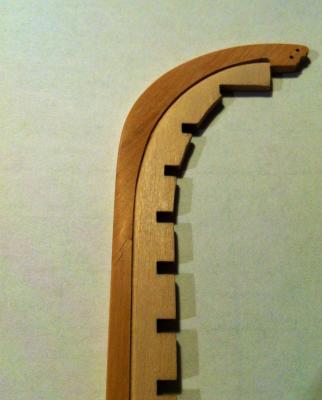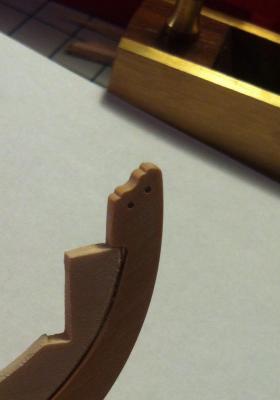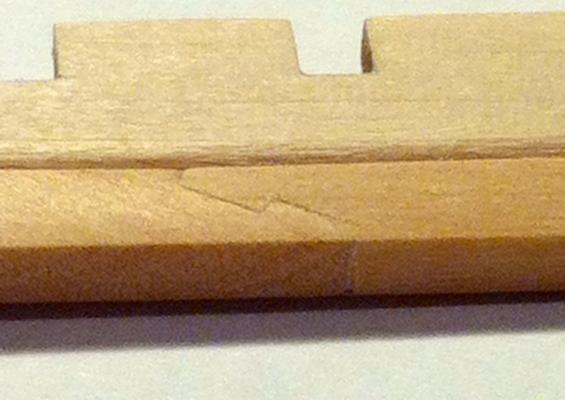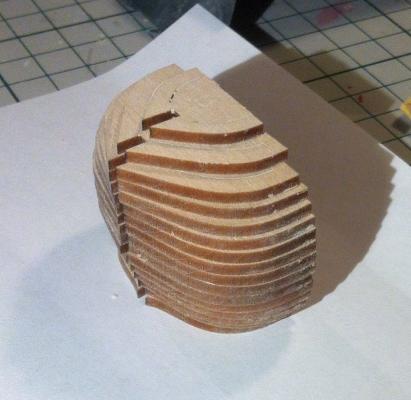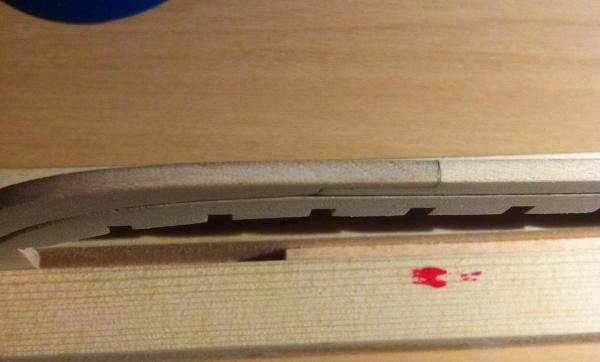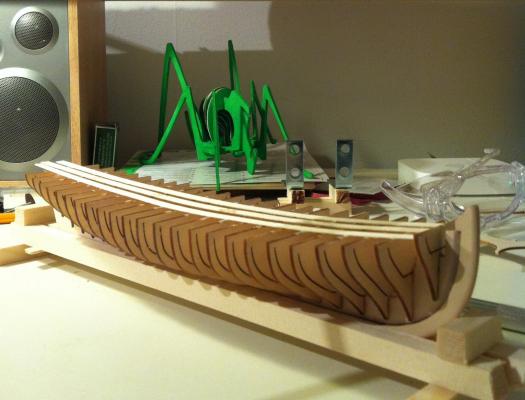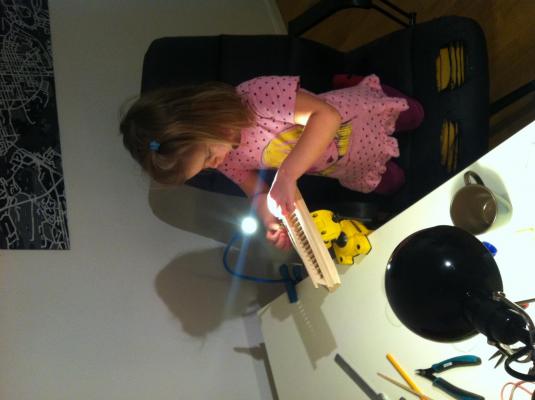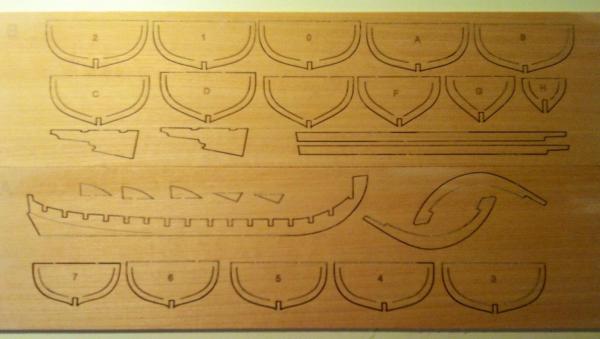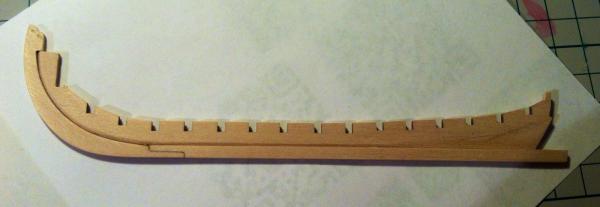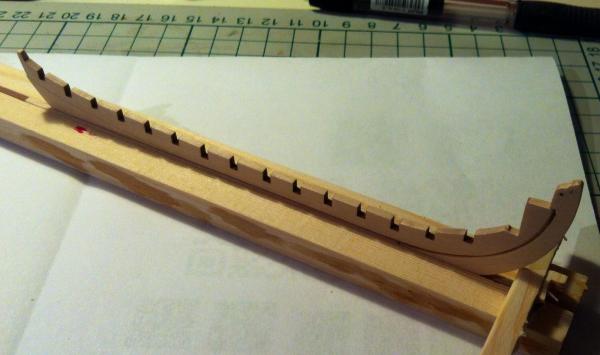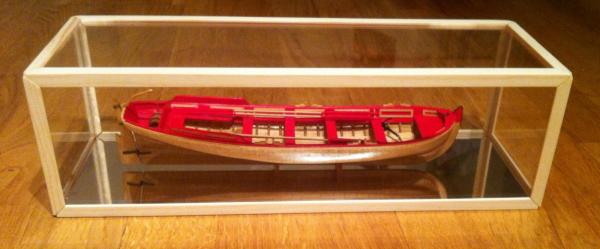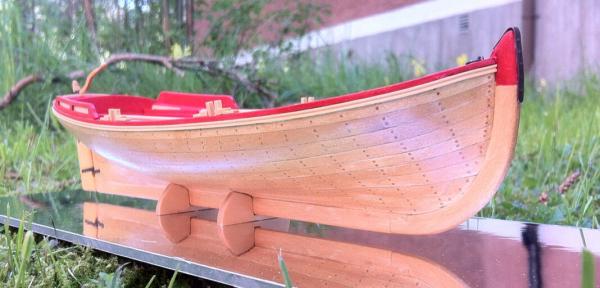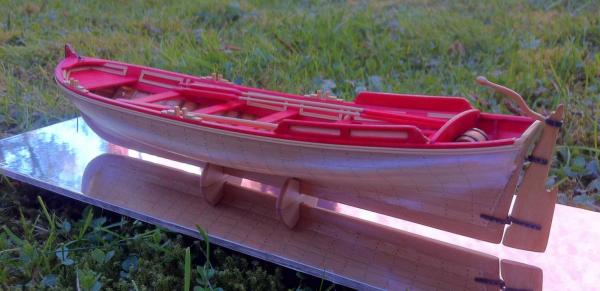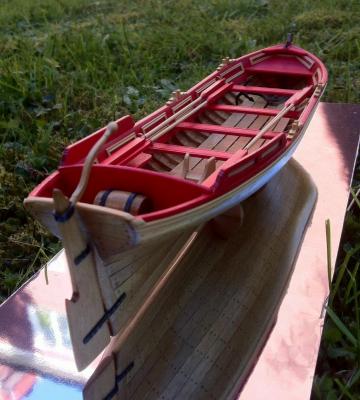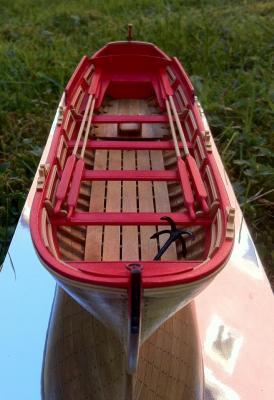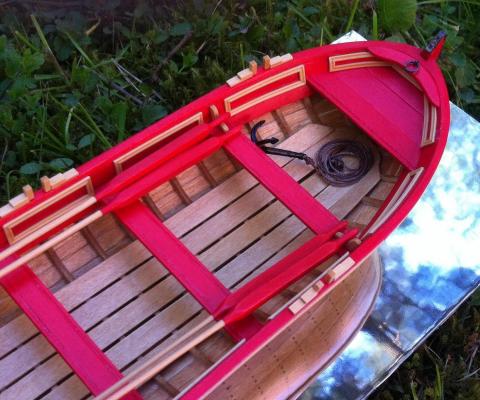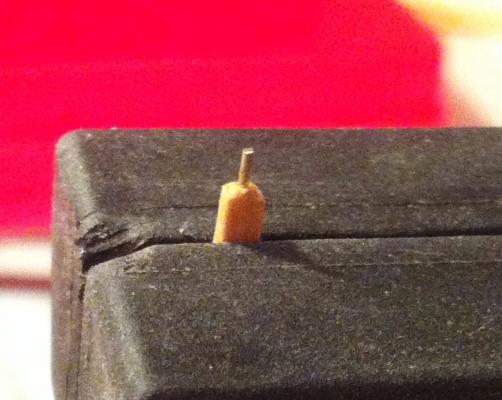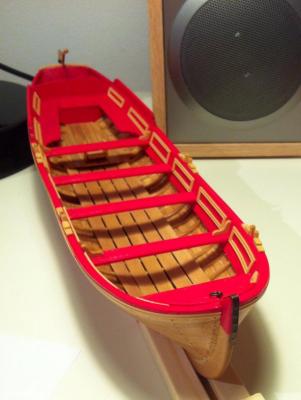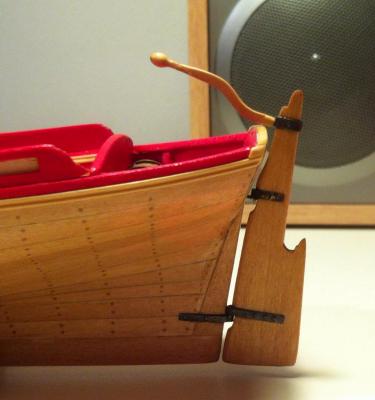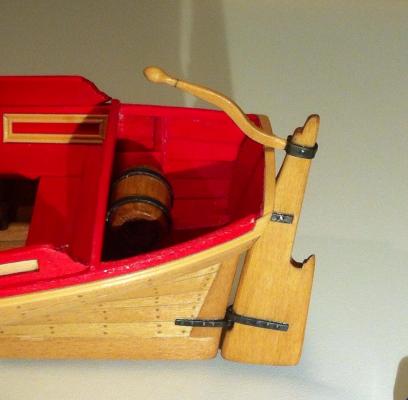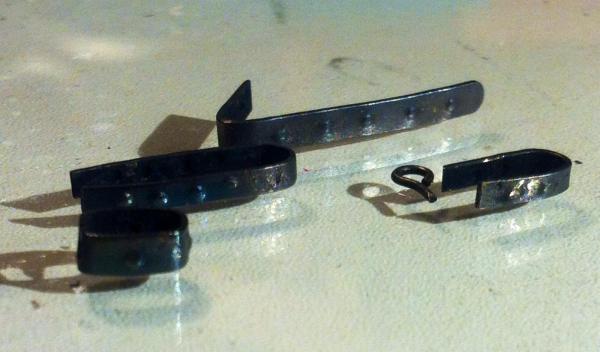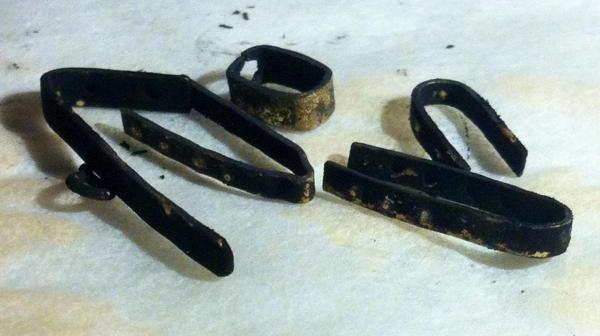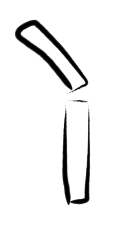-
Posts
1,543 -
Joined
-
Last visited
Content Type
Profiles
Forums
Gallery
Events
Everything posted by Mike Y
-
Ok, boxwood stem and keel looks really better, I actually did not expected how better! Sanded it with 400 => 600 => 1200 => 2000 grits. After 2000 grit castello starts to change the color to a deeper yellow, and starts to have a shine. Really interesting transformation! Need to experiment a lot when it would be a time to apply some protective finish: Used another kind of scarf joint for keel. I know it is not the joint that should be really used on a keel, but it just looks nicer, and just wanted to practice that tricky joint on such scale. Looks ok, or maybe I should have made it longer? Right now joint is done on an angle around 60deg, but maybe something closer to 70-75 would be better (if joint length is three times joint width). What is the golden rule of thumb for such joints? Close-up: Next step is frame fitting. Frames are gently sanded, and ready to go!
-
Floyd, maybe we had kits from different production batches, in my kit the stem have a proper grain direction, and it's not fragile at all. But thanks for a heads up! Actually decided to make stem and keel out of boxwood. The reason is different - stem is a bit grey, and it's not something you can sand away. It's just how basswood looks like when it's cross grain: It's quite visible on a contrast with keel, which have another grain direction. Looks dirty. So making it out of boxwood.
-
Stuntflyer, thanks for coming! Your build log is one of my references! Understood the idea, will try. However, question still applies. What is the benefit of mounting the gardboard plank early on? I installed it quite late on Pinnace, and failed to find any problem caused by it. Or I'm probably just missing something, because lots of experienced builders mount it as early as possible, so it should make some sense. Would appreciate your thoughts!
-
Floyd, no, I didn't applied poly. I will apply it later when things are done. No feeling that it's fragile. Of course, you should handle it with care.. Plus the layer of poly is sooo thin and not so strong, that it will not protect stem from breaking if I, say, hit it with the hand. But also there is no load on a stem. While planking, I clamp the hull using temporary piece of wood glued to frames on top, and frames are connected with each other: I don't have exact photo, but imagine a piece of scrap wood glued right on a center. It's quite a strong construction, hull is flipped upside down and clamped in a table vice, and then only way to break stem is to hit it accidentally
-
Actually never understood the idea of mounting the gardboard plank first. It is quite difficult to get its shape right. I planked pinnace from top to the bottom, and the gardboard was shaped only when I had just 3-4 plank layers left. Then you clearly see remaining width, have enough planks to make fine corrections, and can easilly shape the gardboard as needed. Installing gardboard plank right on the start will require a really good calculations and intuition.. But, again, disclaimer - I'm not a planking expert.. Sorry..
-
Sure! However, I'm also not a planking expert, and will use methods described in some other build logs on that forum, like http://modelshipworld.com/index.php?/topic/1465-18th-century-longboat-by-bobf-ms-148-tri-club/ or http://modelshipworld.com/index.php?/topic/4930-18th-century-longboat-by-stuntflyer-mike-model-shipways/
-
Just in case somebody is interested - I started the longboat build log - http://modelshipworld.com/index.php?/topic/6801-18th-century-longboat-by-mike-y-model-shipways-148/ Nothing interesting there (yet), but a warm welcome to all subscribers of this log, I will try to make it as interesting as possible. Popcorn, beer, sandwiches, sawdust!
- 137 replies
-
- finished
- model shipways
-
(and 1 more)
Tagged with:
-
It is second build, first one was a similar model - English Pinnace This time I will make it slower, no rush. And will try to avoid all mistakes done on Pinnace I will use kit details for frames and keel, and boxwood for everything else. No paint, no stain, only natural wood colour. No friesers, and no paintings on a transom also. Instead, it would be planked and treenailed. Sorry for skipping the decorations, I just prefer the simple design. For a start - traditional photos of every longboat builder - parts sanded from laser char, keel and falsekeel, simple building jig to hold it straight. First pinnace mistake avoided - bevel on a false keel is smaller, different angle, to gently handle a plank on an angle specified by frames. Sounds obvious, but on a pinnace I made a bevel with a wrong angle, and there was a small gap between garboard plank and keel. First impression - it is sooooooo small! Very nice scale, it is big enough to make it with a good precision (I hope), but fits into a palm. Should be very cute when done
-
Thanks for that wave of comments! Finished the display case. I made it out of plexiglass sheets and L shaped furu wood. Looks so-so, CA is not the best way to glue plexiglass, and frankly I failed to cut accurate glass rectangles with required precision. So next time will buy a manufactured case. It sounds ridiculous, but I have no place to put the model on display. This problem slightly crossed my mind before, but I preferred not to think where to put model before it's finished. So now it is going to the drawer, until I move from rental to my own apartment, where I can easily mount a nice shelf on a wall Next build would be a scratch Oliver Cromwell using Hahn's method, but I just ordered it from Lumberyard a few weeks ago. So will start a Longboat build while waiting. Hope that Oliver Cromwell will arrive in a matter of a month or so, hence Longboat would become a side build - when I will feel bored with cutting big pieces into small pieces to make a big pieces to cut them into small pieces to make a big pieces © mtaylor.
- 137 replies
-
- finished
- model shipways
-
(and 1 more)
Tagged with:
-
Remco, thanks again for sharing your knowledge!
- 1,207 replies
-
- sloop
- kingfisher
-
(and 1 more)
Tagged with:
-
Depends on a glue, but with PVA-based wood glues usually one surface is enough. Applying it to two surfaces you will most probably have too many glue, which you will need to remove later. But try your glue on a scrap pieces, the best answer is just an experiment.
- 132 replies
-
- 18th century longboat
- model shipways
-
(and 1 more)
Tagged with:
-
But now the good part. Quoting Chuck's manual - "That completes the model!!!" I'm still in progress with the display case, but she is completed! Yahooo! Chuck, thanks again for that fun build, that looks simple, but actually forces to learn new techniques and go to the next level of accuracy. Next buid would be a Longboat, since my wife really thinks it looks better with sails, and I want to make a better planking with boxwood Ok, in reality I just want to make a pinnace again, this time avoiding all mistakes I did, but making the same model again is kind of silly, and I really love the look of longboat. Also, longboat build would be much slower - I will not rush things to complete it quicker. Thanks everybody who watched, helped and commented - it is quite fun, much better then just modelling without being able to share!
- 137 replies
-
- finished
- model shipways
-
(and 1 more)
Tagged with:
-
Anchor rope in the kit is definitely not as gourgeous as on Chuck's prototype. Frankly, it looks very cheap and definitely not like a rope (more like a wire), but since it is the last bit of a model - I gave up, and decided not to bother with ordering a proper one.
- 137 replies
-
- finished
- model shipways
-
(and 1 more)
Tagged with:
-
Remco, would you mind if I bother you with a next batch of questions regarding finish? it is one of the best I ever saw, so I am trying to learn on best examples! What is the benefit of microcrystalline wax comparing to tung oil, why do you prefer it now? And all that comparing to wipe-on-poly? Do you apply finish to a tiny pieces, like the beds, closets, etc? What finish have you used for frames? And the last one - what is your tactics for when to finish? Do you apply it before gluing, or after? Thanks for all advices!
- 1,207 replies
-
- sloop
- kingfisher
-
(and 1 more)
Tagged with:
-
Hooray! I finished all the messy part of gluing metal parts onto wood parts. Damn CA! Hate it! Metal bumper looks much better then a paper one. Or I probably just cant work with the paper (some build logs of ships from card totally changed the view on paper) Rudder tiller have a brass rod inside to make a stronger joint with a rudder: And here is the rudder installed. Fully functional, you can rotate it gently Trunk of the pinnace looked too empty. Then I started to think... What could be there? It is a flashy pinnace, not the one that is used to carry food supply. It is intended to transport officers. What they could carry with them?? Aha! Some high quality booze, to make sure it will not disappear while officers are on the shore. So here is a tiny booze tank: SKÅL!
- 137 replies
-
- finished
- model shipways
-
(and 1 more)
Tagged with:
-
- 137 replies
-
- finished
- model shipways
-
(and 1 more)
Tagged with:
-
Cracked the reason. My brass was covered with a layer of something transparent, for a nice shiny look. Brushed it away with a metal disk brush, to expose a bare brass. Now it blackens immediately, as expected! Awesome!
- 137 replies
-
- finished
- model shipways
-
(and 1 more)
Tagged with:
-
Got it, will experiment with cleaning/sanding/vinegar before blackening. Thanks!
- 137 replies
-
- finished
- model shipways
-
(and 1 more)
Tagged with:
-
Thanks Dan! Maybe I should not dilute the blackening agent then? After 10min, parts were not black at all. Fist sign of blackness appeared after 30min or so.
- 137 replies
-
- finished
- model shipways
-
(and 1 more)
Tagged with:
-
Blackening liquid arrived (Birchwood Casey), but the first blackening was an epic fail Blackening just falls off, it do not stick at all. I cant take a piece with fingers or tweetzer, the black patina just sticks to fingers, thats it: What has go wrong? My workflow was: 1) put brass parts into acetone for 30min to degrease 2) rinse with water 3) put into blackening liquid diluted with water 1:8 4) wait for 30-60min 5) Actually blackening stopped after 30min, so I added a bit more liquid, maybe it ended up close to 1:6 ratio. 6) removed after 2 hours in liquid 7) rinsed with water 8) left to dry overnight. Maybe I should use another ratio? Or use distilled water instead of tap one? Or? Would appreciate any hints!
- 137 replies
-
- finished
- model shipways
-
(and 1 more)
Tagged with:
-
177x ships - British vs US design, what are the differences?
Mike Y replied to Mike Y's topic in Nautical/Naval History
We should be also careful with comparing that, measurement standards could be different (internal/external could be messed up, for example) -
177x ships - British vs US design, what are the differences?
Mike Y replied to Mike Y's topic in Nautical/Naval History
Thanks druxey! It is a big relief, then I can look on similar ships of that period, ignoring their geographical origin (I'm not a historical correctness maniac anyway ) -
Also, it may sound obvious, but not mentioned in a manual. Shape the inner edge of the plank with a file, to have a better contact between planks, to avoid gaps. No shaping, there most probably would be a gap: Shaped planks, no gaps: P.S.: and, again, do not count on sanding to level your hull and hide planking mistakes. It is purely cosmetic, in that build planks are too thin to be significantly sanded. P.P.S.: good luck, and just start it!
- 132 replies
-
- 18th century longboat
- model shipways
-
(and 1 more)
Tagged with:
About us
Modelshipworld - Advancing Ship Modeling through Research
SSL Secured
Your security is important for us so this Website is SSL-Secured
NRG Mailing Address
Nautical Research Guild
237 South Lincoln Street
Westmont IL, 60559-1917
Model Ship World ® and the MSW logo are Registered Trademarks, and belong to the Nautical Research Guild (United States Patent and Trademark Office: No. 6,929,264 & No. 6,929,274, registered Dec. 20, 2022)
Helpful Links
About the NRG
If you enjoy building ship models that are historically accurate as well as beautiful, then The Nautical Research Guild (NRG) is just right for you.
The Guild is a non-profit educational organization whose mission is to “Advance Ship Modeling Through Research”. We provide support to our members in their efforts to raise the quality of their model ships.
The Nautical Research Guild has published our world-renowned quarterly magazine, The Nautical Research Journal, since 1955. The pages of the Journal are full of articles by accomplished ship modelers who show you how they create those exquisite details on their models, and by maritime historians who show you the correct details to build. The Journal is available in both print and digital editions. Go to the NRG web site (www.thenrg.org) to download a complimentary digital copy of the Journal. The NRG also publishes plan sets, books and compilations of back issues of the Journal and the former Ships in Scale and Model Ship Builder magazines.


